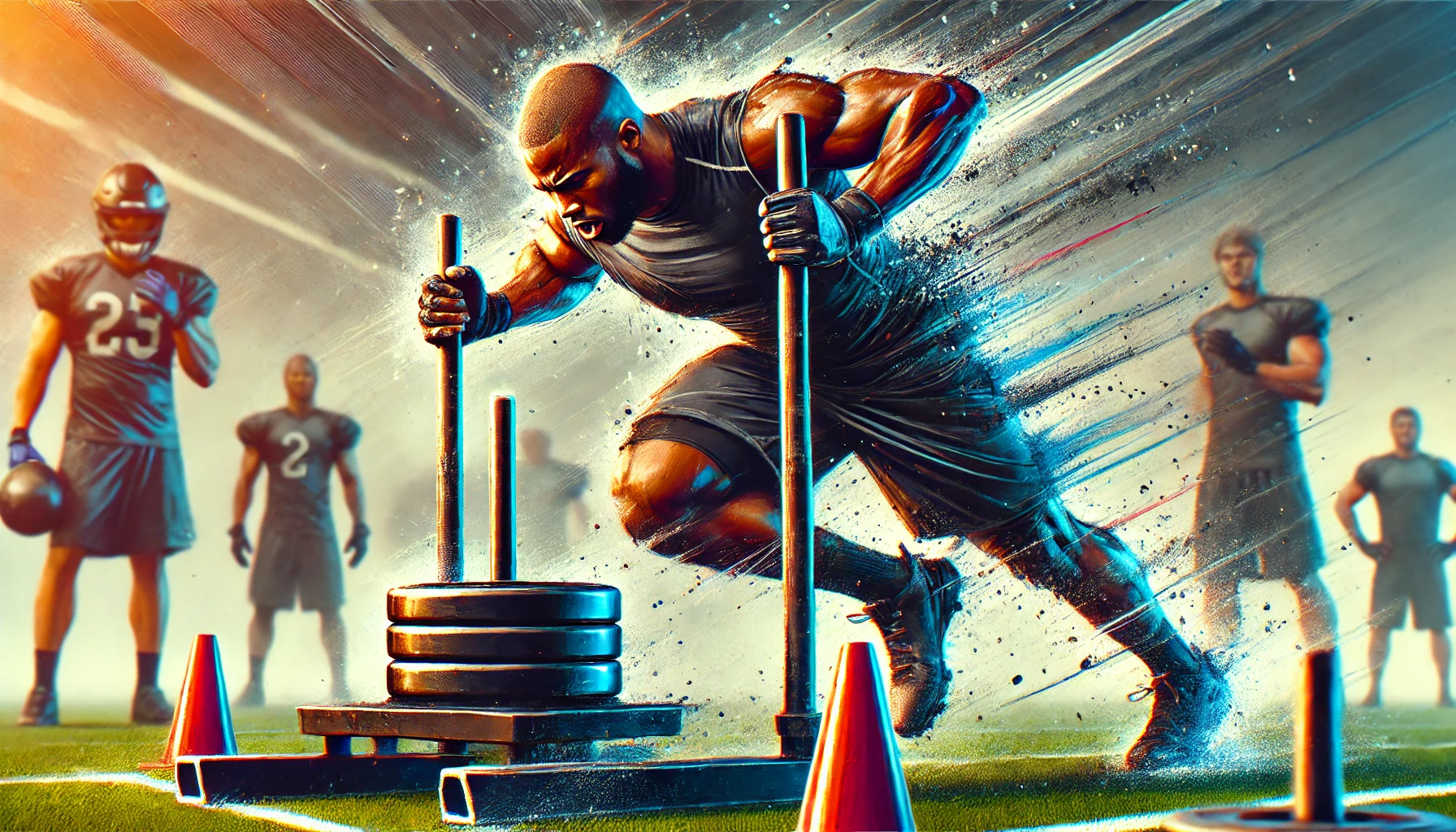A Game Where Physicality Wins
Football is a game of physicality, and every player on the field needs to have the explosive power required to tackle and block effectively. Whether you’re a linebacker trying to take down a ball carrier or an offensive lineman protecting the quarterback, the ability to generate force quickly and with precision can make the difference between a successful play and a missed opportunity. Building explosive power is essential for those looking to elevate their performance and control the line of scrimmage.
Explosive power is the ability to exert maximal force in a short amount of time, and it’s crucial for both offensive and defensive players. Tackling and blocking involve rapid bursts of energy, often in close quarters, demanding the strength and speed to overpower opponents. To develop this kind of power, athletes need to engage in specialized training that emphasizes explosive movement, strength, and coordination. In this article, we will explore how you can build explosive power to enhance your tackling and blocking techniques, and ultimately become more effective on the field.
Understanding Explosive Power in Football
Before diving into specific drills and exercises, it’s important to understand what explosive power is and why it matters for football players. Explosive power is different from pure strength. While strength involves lifting heavy loads, explosive power focuses on applying that strength in a short, fast burst. This is particularly important in football, where players need to generate maximum force quickly—whether it’s sprinting off the line, delivering a powerful hit, or standing firm against an opponent.
In tackling, explosive power helps players close the gap between themselves and the ball carrier, allowing them to execute a clean, forceful tackle. For blockers, it means the ability to push back defenders with speed and force to create opportunities for offensive plays. Essentially, the more explosive power a player can generate, the more effectively they can control the action during a tackle or block.
For instance, when an offensive lineman engages with a defender, he needs to push back with enough force to create space for the running back. This requires both strength and speed—an effective block isn’t just about being big, it’s about using your mass and strength in an explosive way to stop an opponent’s momentum. Similarly, a linebacker needs to rapidly close the distance between themselves and the ball carrier, then deliver a strong, controlled hit.
Thus, developing explosive power is not only crucial for success but also for longevity on the field. Players who lack explosive power often find themselves outmuscled or outpaced, which can lead to injuries or missed plays. By building explosive power, athletes can improve their overall effectiveness and reduce the chances of being outperformed by their opponents.
Building the Foundation: Strength Training for Explosive Power
Strength training is the bedrock for building explosive power. Without a solid foundation of strength, it’s difficult to develop the force needed to be explosive on the field. The first step in building explosive power is developing overall strength, particularly in the lower body and core, which are the primary muscle groups involved in tackling and blocking.
Squats and deadlifts are two of the most effective exercises for developing lower body strength. The squat targets the quadriceps, hamstrings, and glutes, while the deadlift primarily targets the posterior chain, including the glutes, hamstrings, and lower back. Strong legs and a strong core are essential for driving force during a tackle or block. These lifts also engage the stabilizing muscles that help with balance and control during explosive movements.
In addition to traditional compound lifts, Olympic lifts like the clean and jerk or snatch can be incredibly beneficial for developing explosive power. These exercises require the entire body to work in unison, generating rapid force through a combination of strength, speed, and coordination. The clean and jerk, in particular, mimics the explosive nature of a tackle or block by requiring the athlete to lift and then explosively push the barbell overhead. These exercises improve both strength and power output, making them essential for building the type of explosiveness needed for football.
Box jumps and jump squats are also excellent exercises for improving power and explosiveness. These plyometric exercises develop the fast-twitch muscle fibers that are responsible for quick, explosive movements. When performing jump squats, you engage the muscles in the legs, particularly the quads and calves, while also requiring core stabilization to maintain balance. Box jumps require you to generate enough force to jump vertically onto a box, which enhances your ability to explode upward or forward during a tackle or block.
Plyometric Training: Developing Explosive Power
Once a strong base of strength has been established, plyometric training becomes essential for developing the explosive power needed to perform tackles and blocks effectively. Plyometric exercises focus on quick, explosive movements, training the body to exert maximum force in the shortest amount of time. These exercises are critical for improving sprinting, agility, and tackling and blocking power.
Plyometric push-ups are a great way to develop upper body explosiveness. By starting in a standard push-up position and pushing explosively off the ground, you engage the chest, shoulders, and triceps to generate force. This movement mimics the pushing force involved in blocking and helps develop power in the upper body. Plyometric push-ups can be modified by adding claps or using an elevated surface to make the exercise more challenging.
Bounding and lateral jumps are excellent lower body plyometric exercises. Bounding involves jumping forward with a focus on distance, while lateral jumps involve explosive side-to-side movements. Both exercises develop power in the legs and improve the ability to push off quickly, which is essential for generating force in tackles and blocks.
Another effective plyometric exercise for football players is depth jumps. In this exercise, the player drops off a box and immediately jumps as high as possible upon landing. The goal is to maximize the height of the jump, which helps develop explosive power in the legs and improves reaction time. This exercise is particularly beneficial for players who need to accelerate rapidly after making a quick cut or change of direction.
The Importance of Agility and Speed Training
While explosive power is vital for effective tackling and blocking, agility and speed are also crucial components that help maximize a player’s ability to execute these skills. Agility allows players to change direction quickly, while speed enables them to close the distance rapidly or gain ground on their opponent. Together, agility and speed complement explosive power, ensuring that players can move fluidly and effectively in all directions.
One of the most effective agility drills for football players is the cone drill. In this drill, players weave in and out of cones while maintaining a low center of gravity and quick footwork. This drill simulates the lateral movements that are often required during a tackle or block, helping athletes develop quickness and coordination.
Shuttle runs or pro-agility drills are also excellent for improving both speed and agility. In the pro-agility drill, players start at a central point and sprint to one side, then back to the middle, and finally to the other side. This exercise challenges the athlete’s ability to change direction quickly while maintaining speed and control.
Sprints with resistance are another effective way to increase speed and power. Using a sled or resistance band while sprinting can help develop the necessary leg strength and speed for tackling and blocking. These resisted sprints challenge the body to work harder, building muscle strength and power that can translate to explosive movements on the field.
Tackling Drills: Simulating Game Conditions
When it comes to tackling, the ability to apply explosive power at the right moment is key. Tackling drills not only improve physical conditioning but also train athletes to execute controlled, forceful hits under pressure. Several specific drills focus on improving tackling technique, power, and control.
One of the most well-known drills used for tackling is the Oklahoma Drill. This drill is a staple in many football practices and is often used to build strength, explosiveness, and confidence in tackling. In the Oklahoma Drill, two players face off against each other—one plays offense, while the other plays defense. The offensive player attempts to run the ball, while the defensive player must make the tackle. The drill is highly competitive and helps develop explosive power as players are forced to engage quickly, use proper tackling form, and apply maximum force.
Another effective drill for improving tackling power is the tackling sled drill. In this drill, players use a tackling sled, which mimics the impact of an opponent’s body. Players lower their shoulder and drive through the sled, focusing on using their legs to generate power and drive. This drill helps improve the lower body’s explosiveness and reinforces the technique of driving through the hips while maintaining a strong base.
The wrap-and-drive drill is another great drill for teaching players how to maintain control during a tackle. Players start by wrapping their arms around a tackling dummy or bag and driving it backward, simulating the way they would wrap up an opponent in a real game situation. This drill reinforces proper form and helps build upper body strength to improve the tackling technique.
Blocking Drills: Developing Power and Control
Just as tackling requires explosive power, blocking is equally dependent on a player’s ability to generate force quickly. Offensive linemen, in particular, need to develop explosive strength and speed to push defenders back and protect their quarterback or running back. There are several blocking drills that help players build power while maintaining balance and control.
Drive-blocking drills involve players pairing up, with one acting as the offensive lineman and the other as a defensive player. The goal is to drive the defensive player back, using explosive power to maintain control and position. This drill helps develop the lower body strength needed to initiate blocks and provides the upper body engagement required for effective contact. Players focus on using their hips and legs to generate the power for blocking, ensuring they stay balanced and maintain their leverage throughout the movement.
The punch-and-drive drill is another important blocking drill. In this drill, offensive linemen practice using their hands to punch the defender while simultaneously driving forward with their legs. The punch allows players to disengage the defender and create space, while the drive generates the power needed to control the block and open lanes for running backs.
Recovery and Nutrition: Maximizing Performance and Preventing Injury
As with any training program, recovery is key to maximizing the gains from explosive power training. Overworking the muscles without proper rest can lead to fatigue, injury, and decreased performance. Football players need to make recovery a priority, ensuring that they allow their muscles to repair and rebuild after intense workouts.
Proper nutrition is also critical for maintaining energy levels, building muscle, and supporting recovery. Consuming adequate protein helps repair muscle tissue after training, while carbohydrates provide the energy required for explosive movements. Healthy fats support joint health, which is important for tackling and blocking. Hydration is equally important, as dehydration can lead to decreased performance and muscle cramps.
Consistency and Commitment
Building explosive power for effective tackling and blocking takes time, dedication, and consistency. The best football players don’t just train hard; they train smart. By consistently focusing on strength training, plyometrics, speed, agility, and core strength, athletes can develop the power and explosiveness needed to dominate on the field.
To truly become a force to be reckoned with on the field, players must continually challenge themselves to grow stronger, faster, and more explosive. Stay committed to your training, focus on the fundamentals, and put in the work. With the right approach and relentless effort, you’ll build the explosive power that can transform your tackling and blocking game, making you a key player on every play. Keep pushing your limits, and soon you’ll become an unstoppable force on the field.




